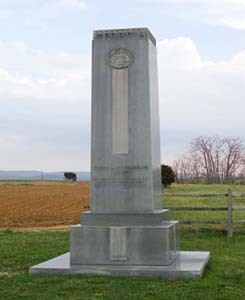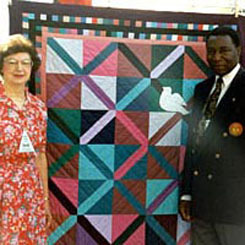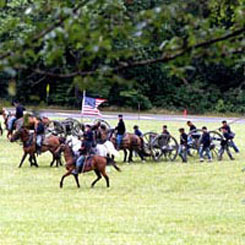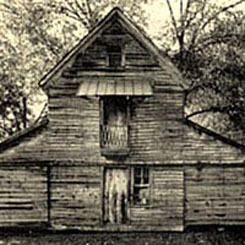
- Capital City:
- Atlanta
- Nickname:
- Peach State / Goober state/ Empire State of the South
- Motto:
- Wisdom, justice, and moderation
- Statehood:
- January 2, 1788 (4th)
- Origin of State's Name:
- Named for King George II of England.
- Largest Cities:
- Atlanta, Columbus, Savannah, Macon, Albany
- Border States:
- Alabama, Florida, North Carolina, South Carolina, Tennessee
- Land Area:
- 57,919 sq. mi.; 21st largest
- State Bird:
- Brown Thrasher
- State Flower:
- Cherokee Rose (rosa laevigata)
- State Tree:
- Live oak (quercus virginiana)
- State Song:
- Georgia on My Mind
Known today as the "Peach State," Georgia, founded in 1733, is one of the original 13 states. It was named in honor of England's King George II. During the Civil War, the fall of Atlanta was a crucial turning point in the defeat of the South. Today, Atlanta, which became Georgia's capital in 1868, is a thriving city with major national corporations, and it is considered the economic and cultural center of the Southeast. The state flower is the Cherokee rose.
The West Georgia Quilters Guild: A Legacy in Stitches

The guild was founded in September 1987 by Carol Kelley, a quilter, after she moved to Carrollton from Omaha and, much to her dismay, found that there was no local quilt guild. The guild has grown to forty members whose goals are to share the craft, history, and love of quilting with their community, family and friends. The making of a quilt is an art that can take many forms. Some quilts are made from traditional patterns, such as the Log Cabin Quilt or the Wedding Ring Quilt. Others take on historical patterns, such as the Crazy Quilt. Many quilters choose to use a combination of traditional patterns, as well as blend their own interests and personalities into the quilt's pattern. Among the group's most important projects are its group quilts.
The West Georgia Quilters Guild is a blend of old and young, experienced and novice quilters, and with this blend comes a variety of techniques, patterns, and quilted art. The guild wants to share their talent with the community and to show how quilts can tell much about our history. They have accomplished this feat with many community service projects, such as providing handmade quilts for charity raffles and for placement in new community buildings.
The guild participated in a project of international scope when Atlanta was honored to host the Summer Olympic Games in 1996. In preparation for this event, the West Georgia Quilters Guild put out a call to all quilters in the state to submit quilts for a special project. The aim was to provide the flag bearer and the president of the Olympic committee from each country with a quilt from Georgia. Six quilts were chosen from guild members and given to the countries of Uganda, Hungary, Ethiopia, Albania, Nicaragua, and Turkmenistan.
The guild shares their work with the community at their annual February exhibition in the Bess Harman Williamson Cultural Arts Center at the Neva Lomason Memorial Library in Carrolton. This exhibition features at least 50 quilts and quilted wall hangings. No quilt is shown twice, except for two Olympic quilts. The popular exhibit attracts 12,000 visitors each year.
Commemoration of the Battle of Kennesaw Mountain

In 1999, the 135th anniversary of the Civil War Battle of Kennesaw Mountain was commemorated with three days of activities and the opening of new addition to the visitor center at Kennesaw Mountain National Battlefield Park. Although it was a rainy weekend, an estimated 40,000 people viewed one or more programs, which included infantry drills, a cavalry drill, civilian society demonstrations, camp life programs, and a six-gun union artillery battery at the anniversary celebration.
The Battle of Kennesaw Mountain on June 27, 1864, was an important battle of the Atlanta campaign by Union General William Sherman to launch a full-scale frontal assault on the entrenched position of General Joseph Johnston's Rebels. Eventually Sherman abandoned his frontal assault and went back to his famous flanking maneuvers. This battle cost the lives of 3,000 Union soldiers, and 1,000 Confederates. On September 2, 1864, the first Union troops occupied Atlanta, which was destroyed during the next few weeks.
Following the war, a number of veteran reunions were held at battlefields. Several battlefields, which did not include Kennesaw, were saved from destruction for professional military and historical study. Civil War veterans from Illinois, however, purchased 60 acres at the center of the Kennesaw battlefield where they had been heavily engaged on June 27. They also erected a monument to commemorate the heroic deeds of the men and officers that day. Kennesaw was authorized as a national battlefield on February 8, 1917, and became a national park in 1935. Over time the area around the park has become greatly developed. Since 1935, surrounding communities have participated in the battle's annual commemoration, which continues to draw larger crowds as interest grows yearly about the war, its causes, implications, and battles.
Shields-Ethridge Heritage Farm

An outdoor agricultural museum, the Shields-Ethridge Heritage Farm functions as an educational and interpretive center in northeast Georgia. Listed on the National Register of Historic Places, the farm is unique for its collection of over 20 intact historic buildings in their original location.
Dating from ca. 1900-1920, the buildings served the agricultural needs of the Shields-Ethridge family and surrounding farms, functioning as a small industry in the cultivation of corn, wheat, and other crops. With very few changes, these buildings can be viewed today, including a schoolhouse called the "Bachelor's Academy," teacher's residence, grist mill, hammer mill, blacksmith shop, carpenter's shop, cottonseed warehouse, cotton gin, main house, tenant house, and others. The grist mill and a fully stocked commissary appear just as they did in the early 1900's. The farm's original equipment and machinery can also be viewed, including a restored Titan Ten engine, circa 1913, 3 Lummus gins, hydraulic balers, generators, generator, hay rakes, and wagon scales.
The farm has remained in the same family since its purchase ca. 1802. During the Civil War, the farm produced wheat, corn, oats, cured fodder, cotton and feed. In 1865, at the end of the Civil War, the freed slaves left the farm, but shortly thereafter requested to return and live on the farm. They returned under a signed agreement as free people. The main house was built in 1866 with the money from the sale of two bales of cotton. By 1880, the farm tilled over 100 acres of land, making it one of the largest farms in the area.
In 1994, Joyce Ethridge and her daughters Susan E. Chaisson and Ann E. Lacey gave 150 acres of the farm to the Shields-Ethridge Farm Foundation, Inc., a non-profit organization dedicated to the preservation of the farm as an agricultural museum. The Foundation protects the farm complex and provides the public with an educational and interpretive facility that accurately tells of Georgia's rich agricultural history. Today the museum hosts regular seminars and tours, annual events, educational outings for area school children, and is open to the public.
In 1994, the Shields-Ethridge farm received a Georgia Centennial Heritage Farm award from the Georgia Department of Natural Resources that recognizes farms of exceptional historical value.
In 1996, Mrs. Ethridge received the Georgia Trust for Historic Preservation Stewardship Award for Long Term Preservation of Historic Properties. In 1999, the farm received a Silver Level Recognition Environmental Award from the Jackson County Area Chamber of Commerce and the Boy Scouts of America.
 Print
Print Email
Email







